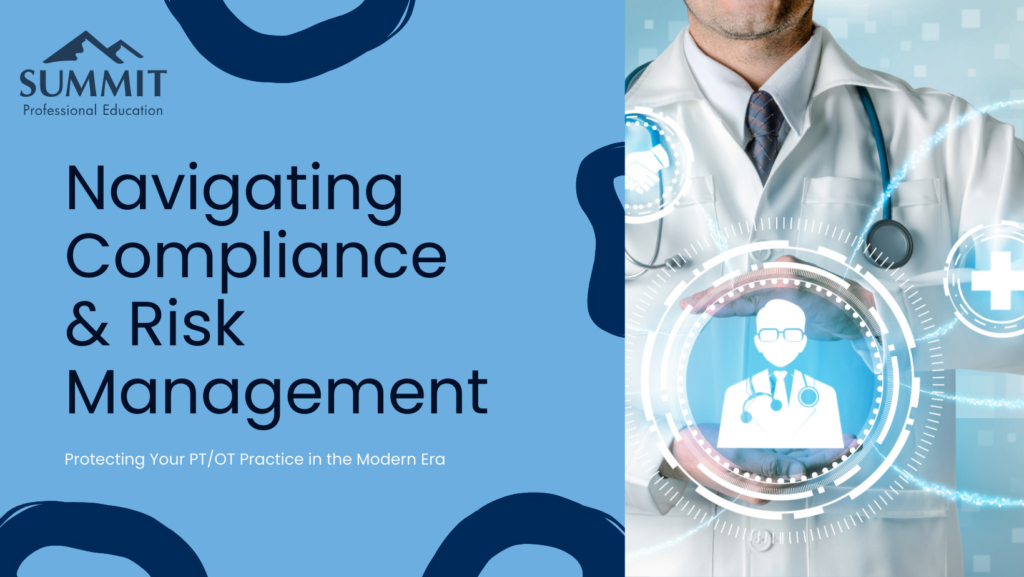Written by the Summit Professional Education Team, experts in continuing education for healthcare and allied professionals

Navigating Compliance & Risk Management: Protecting Your PT/OT Practice in the Modern Era
In the current climate of healthcare delivery, where regulations are tightening and reimbursement models are shifting, compliance and risk management are often viewed as bureaucratic necessities—checkbox exercises to avoid penalties. But what if we’re framing the issue too narrowly? What if compliance isn’t just about legal protection, but an overlooked opportunity to build trust, reduce burnout, and foster a more resilient, values-aligned culture?
It’s time to challenge the prevailing notion that compliance must live in tension with patient care or staff morale. In fact, the most effective PT and OT practices are finding that when approached with the right mindset, compliance and risk mitigation can act as strategic levers—not just legal safeguards.
The Problem with Compliance-as-Punishment
Much of traditional healthcare compliance operates from a paradigm of fear. Rules are enforced to avoid lawsuits. Audits are dreaded. Checklists proliferate. Staff compliance is monitored, but rarely internalized. This model breeds resentment, fatigue, and disconnection. Clinicians begin to see policy as an obstacle to care, rather than a reflection of ethical and effective practice.
What’s lost in this dynamic is the deeper purpose of compliance: to protect patients, providers, and the integrity of care itself. In physical and occupational therapy, where hands-on treatment, patient relationships, and long-term outcomes intersect, a compliance mindset rooted in fear can be particularly corrosive. Clinicians stop reporting near misses. Teams conceal documentation gaps. Leaders avoid open dialogue, and the entire culture becomes reactive rather than resilient.
Redefining Risk: Relationship-Centered Safety
Risk is often equated with liability—but the more immediate risk in most PT/OT practices lies in a breakdown of communication, culture, and care. When clinicians are rushed or unsupported, when documentation is siloed or inconsistent, when feedback loops are absent, patients suffer. And when patients suffer, so do clinicians—morally, emotionally, and professionally.
The antidote isn’t just more rules. It’s relationship-centered risk management. This means fostering a culture where:
– Documentation is not just required, but valued as a shared narrative of care
– Errors are surfaced without blame, enabling rapid learning
– Training emphasizes ethical reasoning and human impact, not just technical accuracy
– Clinicians are supported in understanding *why* policies exist—not just what they are
Leaders can shape this culture through modeling transparency, reinforcing shared values, and inviting frontline input into policy design. When staff feel ownership over the rules that govern them, compliance becomes a form of care—not control.
From Reactive to Proactive: CE as a Risk Strategy
Continuing education is often treated as an annual obligation. But for practices serious about mitigating risk, CE is one of the most underleveraged tools available. Proactive upskilling—especially in ethics, patient communication, documentation practices, and emerging care standards—can prevent downstream issues while reinforcing staff engagement and competence.
This is particularly critical for newer clinicians who may not yet have internalized the nuances of informed consent, clinical reasoning, or documentation required for legal defensibility. But even experienced providers benefit from refreshers that reflect updated case law, billing regulations, and evolving patient expectations.
Consider creating CE pathways aligned with identified areas of risk in your practice. If patient complaints often involve poor communication, require annual CE in motivational interviewing. If audits reveal inconsistent SOAP note structure, offer refresher courses on documentation best practices. Education tied to real-world challenges enhances relevance, retention, and results.
Recruitment, Development, and Retention: The Compliance Connection
Compliance is often seen as a downstream concern—something dealt with *after* hiring. But high-functioning organizations understand that your risk profile is directly shaped by who you hire, how you support them, and whether they stay.
Start by baking compliance competencies into your recruitment messaging. Emphasize that you’re looking for clinicians who value ethical decision-making, transparent communication, and continuous improvement. This signals to applicants that safety and integrity are non-negotiable.
Then, build development frameworks that reinforce this from day one. Orientation should include not just the “rules” but their rationale. Pair new hires with seasoned mentors who exemplify safe, ethical care. Offer regular reflective practice groups or compliance “rounds” where staff can discuss gray areas in real-time.
Retention is equally critical. When clinicians feel empowered, not policed, they’re more likely to remain engaged—and less likely to commit errors that lead to litigation or burnout. A psychologically safe environment reduces turnover, improves reporting, and creates a virtuous cycle of safety and trust.
Conclusion: Rethinking Protection
Compliance and risk management need not be sterile, fear-driven processes. Done well, they can become extensions of your clinic’s deeper values—respect for patients, integrity in practice, and care for the clinicians who do the work.
The future belongs to PT and OT practices that treat compliance not as a box to check, but as a living framework for ethical, excellent care. In doing so, they not only protect themselves from risk—they position themselves as places where patients thrive and professionals want to stay.
In this reimagined model, compliance becomes what it was always meant to be: a promise made visible—one that says we are trustworthy, we are prepared, and we are committed to doing the right thing, even when no one is watching.
Interested in Exploring Group Discounts? CLICK HERE
About Summit Professional Education
Summit equips Physical Therapists, Occupational Therapists and SLPs with better continuing education courses that provide CEUs while impacting patient outcomes. Find high-quality on-demand CE along with the largest offering of live options — including live webinars, live streams, and in-person courses. Want to deep dive on a topic? Summit offers hundreds of 6-hour courses for the most in-depth learning!
